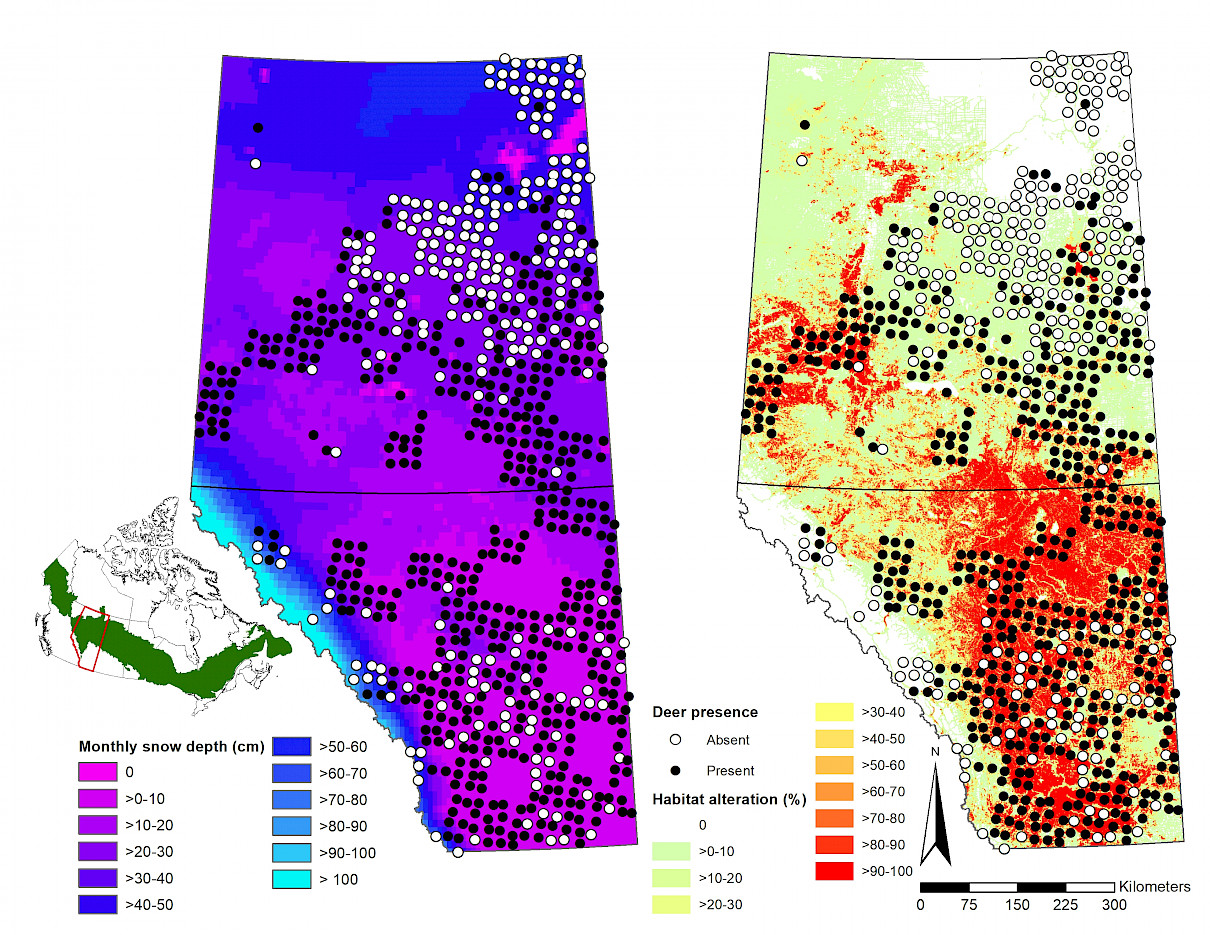Nature is kind of like the game Jenga, with many blocks working together to keep the structure balanced. Just like in Jenga, if the wrong changes are made, the whole structure can come crashing down. In the wild, each species and component of the environment interacts to maintain ecosystem functions, just like individual Jenga blocks. It can be difficult to predict how changes will ripple through the ecosystem. Nevertheless, this is what conservationists try to accomplish, to manage species and habitats.
In Canada, white-tailed deer are expanding, and their increasing numbers have been linked to declining caribou populations (Côté et al. 2004, Latham et al. 2011, Hervieux et al. 2013, Dawe and Boutin 2016). Caribou are currently listed as Threatened under the Canadian Species at Risk Act. Deer expansion leads to an increase in predators such as wolves and bears, which inevitably prey on caribou. Therefore, it is important to investigate the causes of deer expansion to inform caribou recovery strategies.

In Alberta, changing climate and human footprint are both believed to facilitate white‐tailed deer expansion. First, milder winters due to climate change may increase white-tailed deer survival and reproductive rate, leading to deer expansion (Dawe et al. 2014, Dawe and Boutin 2016). On the other hand, human footprint, such as linear features and cutblocks, has been expanding across space. These changes to habitat may be advantageous for white-tailed deer by removing forest cover, increasing the abundance of vegetation preferred by deer as forage (Fisher and Burton 2018, Latham et al. 2011). The goal of our study was therefore to examine the relative effects of both human footprint and climate change, using snow depth as the main indicator, on deer abundance and distribution.
We used data from 2,842 cameras deployed at 767 sites across the province of Alberta from 2015 to 2019. They were deployed in groups of 4, and took more than 200,000 pictures of white-tailed deer. From these pictures, we evaluated whether deer were present at each site, and if so the density of deer. We split our analysis into the northern and southern regions of the Province of Alberta to help deal with the confounding effect of latitude – human footprint decreases farther north, but winters also become more severe (Figure 2).

Snow data: Copernicus Climate Change Service. 2019. C3S ERA5‐Land reanalysis. Accessed June 2020.
Human footprint data: Wall-to-wall Human Footprint Inventory from the Alberta Biodiversity Monitoring Institute.
We found that more snow led to a decrease in deer presence, but deer presence was higher in areas with higher human footprint only in the north. In addition, winter deer density decreased with increasing snow, whereas spring density increased with human footprint.
Our results suggest that limiting human footprint expansion and restoring footprint may slow or reverse deer expansion, particularly in the north of the province. However, climate change will likely continue to facilitate expansion as winters become less severe. Unfortunately, climate is harder to mitigate than human footprint- and for this reason, managers may have to consider additional strategies for deer population management.
Author: Maud Laurent is currently working with the ABMI as a field technologist in Alberta. She completed her MSc in Ecology and Ethology in France in 2018, during which she did an internship at the University of Alberta with the Caribou Monitoring Unit. There, she did some fieldwork and was able to access many resources to help better understand the complexity of caribou decline, and decided to focus her research on white-tailed deer expansion. Since then, she has worked in different countries on the impact of human populations on wildlife and the protection of natural areas. When not working, Maud can be found rock climbing at local gyms or in the Rockies near Jasper or Banff.
REFERENCES:
Côté, S. D., T. P. Rooney, J. P. Tremblay, C. Dussault, and D. M. Waller. 2004. Ecological impacts of deer overabundance. Annual Review of Ecology. Evolution and Systematics 35:113–147.
Dawe, K. L. 2011. Factors driving range expansion of white‐tailed deer, Odocoileus virginianus, in the boreal forest of northern Alberta, Canada. Dissertation, University of Alberta, Edmonton, Canada.
Dawe, K. L., E. M. Bayne, and S. Boutin. 2014. Influence of climate and human land use on the distribution of white‐tailed deer (Odocoileus virginianus) in the western boreal forest. Canadian Journal of Zoology 92:353–363.
Dawe, K. L., and S. Boutin. 2016. Climate change is the primary driver of white‐tailed deer (Odocoileus virginianus) range expansion at the northern extent of its range; land use is secondary. Ecology and Evolution 6:6435–6451.
Fisher, J. T., and A. C. Burton. 2018. Wildlife winners and losers in an oil sands landscape. Frontiers in Ecology and the Environment 16:323–328.
Hervieux, D., M. Hebblewhite, N. J. DeCesare, M. Russell, K. Smith, S. Robertson, and S. Boutin. 2013. Widespread declines in woodland caribou (Rangifer tarandus caribou) continue in Alberta. Canadian Journal of Zoology 91:872–882.
Latham, A. D. M., M. C. Latham, N. A. McCutchen, and S. Boutin. 2011. Invading white‐tailed deer change wolf‐caribou dynamics in northeastern Alberta. Journal of Wildlife Management 75:204–212.
Note: Figure 2 reprinted from “Evaluating the mechanisms of landscape change on white-tailed deer populations,” by M. Laurent, M. Dickie, M. Becker, R. Serrouya and S. Boutin, 2021, The Journal of Wildlife Management, 85(2), 340-353. Copyright (2020) by Wiley Periodicals LLC (“Wiley”) for The Wildlife Society